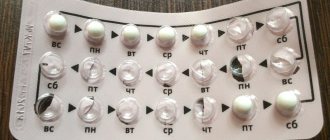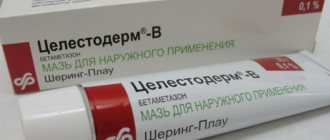Degenerative-dystrophic joint pathologies are characterized by a chronic course. During their long-term treatment, it is important that the medications used are effective and harmless. For this reason, drugs from the structure-modifying group are becoming increasingly popular in the treatment of rheumatological diseases. One of these medications is Teraflex Advance. The medication, according to its pharmacological properties, is a combination of a chondroprotector and a non-steroidal anti-inflammatory drug.
Release form and composition
The drug is available in the form of capsules: hard gelatin, size No. 0, opaque, with a white body and a blue cap, with the blue inscription THERAFLEX ADVANCE printed on top of the capsules; the contents of the capsules are white or almost white powder (30, 60 or 120 pieces each in polyethylene bottles with a polypropylene screw cap, one bottle in a cardboard box along with instructions for use of Teraflex Advance).
Composition per capsule:
- active ingredients: chondroitin sulfate sodium – 200 mg, glucosamine sulfate (in the form of D-glucosamine sulfate potassium chloride) – 250 mg, ibuprofen – 100 mg;
- auxiliary components of the capsule contents: corn starch, crospovidone, silicon dioxide, microcrystalline cellulose, stearic acid, magnesium stearate, povidone, sodium carboxymethyl starch;
- body and capsule cap: titanium dioxide, gelatin, brilliant blue dye, aluminum varnish;
- Inscription ink: dehydrogenated ethyl alcohol USP, butyl alcohol NF, shellac NF, propylene glycol USP, indigo carmine aluminum varnish, isopropyl alcohol USP, ammonia solution NF, titanium dioxide USP.
Pharmacological properties
Pharmacodynamics
Teraflex Advance is a combination product containing glucosamine sulfate, chondroitin sulfate and ibuprofen, which determine its therapeutic effect:
- glucosamine sulfate: a polysaccharide of cartilage tissue, part of glycoproteins, promotes the synthesis of hyaluronic acid, proteoglycans, chondroitinsulfuric acid and other substances that are part of the intra-articular fluid, cartilage tissue and joint membranes;
- chondroitin sulfate: mucopolysaccharide, is an important component of bone, cartilage, as well as a number of other connective tissues, takes part in their formation and restoration. It protects cartilage from destruction and also improves joint mobility;
- ibuprofen: a derivative of propionic acid. It has antipyretic, analgesic and anti-inflammatory effects by indiscriminately inhibiting the synthesis of COX-1 (cyclooxygenase-1) and COX-2 (cyclooxygenase-2).
Chondroitin sulfate and glucosamine sulfate potentiate the analgesic effect of ibuprofen.
Pharmacokinetics
- Glucosamine: When taken orally, it undergoes first pass through the liver, so its bioavailability is only about 25%. The highest concentrations of the substance are found in articular cartilage, liver and kidneys. Approximately 30% of glucosamine taken is present in muscle and bone tissue over a long period of time. Most of the substance is excreted unchanged in the urine, some in the feces. The half-life (T1/2) is 68 hours;
- chondroitin sulfate: more than 70% is absorbed in the gastrointestinal tract. Its bioavailability is approximately 13%. After a single use of an average therapeutic dose of the drug, the maximum concentration of chondroitin in plasma is achieved after 3–4 hours, and in synovial fluid – after 4–5 hours. The substance absorbed in the digestive tract accumulates in the synovial fluid and is then excreted by the kidneys;
- ibuprofen: well and quickly absorbed. It takes about 1 hour to reach maximum plasma concentration. Approximately 99% of ibuprofen is bound to plasma proteins. It is distributed throughout organs and tissues, accumulates in synovial fluid and is excreted from it more slowly than from plasma. Metabolized in the liver; the main metabolic pathways are hydroxylation and carboxylation of the isobutyl group (with the participation of the CYP2C9 isoenzyme). Ibuprofen is absorbed in the pharmacologically inactive R form, which then slowly transforms into the active S form. Elimination is two-phase. The half-life is 2–3 hours. Almost 90% of the dose taken is found in the urine in the form of metabolites and their conjugated derivatives. Less than 1% of ibuprofen is excreted in unchanged form (in urine and in small amounts in bile). Complete elimination of the substance occurs within 24 hours.
Contraindications
Absolute:
- severe renal failure, progressive kidney disease;
- severe liver failure, liver disease in the acute phase;
- bleeding from the gastrointestinal tract;
- erosive and ulcerative lesions of the digestive tract (including ulcerative colitis and Crohn's disease, as well as exacerbation of gastric and duodenal ulcers);
- severe heart failure;
- hyperkalemia (confirmed);
- postoperative period after coronary artery bypass surgery;
- hemorrhagic diathesis and bleeding disorders;
- patient age under 18 years;
- During pregnancy and breastfeeding;
- a combination of recurrent polyposis of the paranasal sinuses and nose, bronchial asthma and intolerance to acetylsalicylic acid (a complete or incomplete combination of these factors);
- increased individual sensitivity to the main or auxiliary components, as well as acetylsalicylic acid and/or other non-steroidal anti-inflammatory drugs (including a history).
Relative (Teraflex Advance is used with caution):
- renal failure of mild or moderate severity, nephrotic syndrome;
- liver failure of mild or moderate severity, liver cirrhosis with high pressure syndrome in the portal vein system;
- indications in the anamnesis of gastric and duodenal ulcers;
- presence of Helicobacter pylori infection;
- heart failure, coronary heart disease;
- blood diseases of unknown origin;
- enteritis, gastritis, colitis;
- high blood pressure;
- bronchial asthma;
- tuberculosis;
- cerebrovascular diseases;
- diabetes;
- hyperlipidemia;
- hyperbilirubinemia;
- peripheral arterial disease;
- severe somatic diseases;
- presence of bad habits (alcoholism, smoking);
- elderly age;
- intolerance to shrimp, shellfish and other seafood (the risk of allergic reactions to the drug increases);
- long-term therapy with non-steroidal anti-inflammatory drugs;
- simultaneous use of antiplatelet agents, anticoagulants, selective serotonin reuptake inhibitors and glucocorticosteroids.
Instructions for use
Take Theraflex Advance for a short course, if there are no additional instructions from the doctor, then no longer than 3 weeks. Next, it is recommended to switch to standard capsules
Teraflex. The instructions prescribe 3 times taking 2 capsules (daily dose - 6 capsules). Take after meals, do not crush, swallow whole with a small amount of still water. During long-term treatment, you should monitor your blood picture and take kidney and liver tests. If the recommendations are not followed, an overdose of Ibuprofen is possible, which can be expressed:
- pain in the abdomen, vomiting, nausea;
- lethargy, craving for sleep, depression;
- headache, ringing in the ears;
- acid-base balance disorder, sudden renal failure;
- drop in pressure, arrhythmia, coma, cessation of respiratory activity.
Having discovered such symptoms, it is necessary to urgently remove the remnants of the drug from the body by washing the stomach, taking milk with soda, activated charcoal, or artificially stimulating urination in another way. Increased caution is required in patients with blood diseases, gastrointestinal tract diseases, liver cirrhosis, cardiovascular, renal, hepatic dysfunction, diabetes and in old age.
Teraflex Advance is contraindicated for use if there is:
- individual intolerance to aspirin, NSAIDs or one of the components of the capsules;
- diseases of the gastrointestinal tract in the acute stage, gastrointestinal bleeding syndrome;
- combinations of polypous rhinosinusitis with bronchial asthma;
- detected hyperkalemia;
- decreased blood clotting and other pathologies of the hematopoietic system;
- hemorrhages in the cranial cavity;
- severe disorders in renal and hepatic processes;
- postoperative period after coronary artery bypass grafting;
- childhood and adolescence – 0-18 years;
- pregnancy or breastfeeding.
Side effects
Theraflex Advance may cause side effects such as abdominal pain, nausea, constipation, diarrhea, flatulence and allergic reactions. The listed adverse events disappear on their own after discontinuation of the drug.
In addition, the likelihood of side effects due to the ibuprofen content in Theraflex Advance should be taken into account:
- digestive system and liver: aphthous stomatitis, mouth pain, dryness and irritation of the oral mucosa, ulceration of the gum mucosa, heartburn, nausea, decreased appetite, vomiting, flatulence, abdominal pain, pancreatitis, hepatitis, constipation or diarrhea, exacerbation of Crohn's disease and colitis, ulceration of the mucous membranes of the gastrointestinal tract (sometimes complicated by perforations and bleeding);
- cardiovascular system: increased heart rate, worsening existing or newly emerging heart failure, increased risk of arterial thrombosis, increased blood pressure;
- respiratory system: bronchospasm, dyspnea;
- central and peripheral nervous system: insomnia or drowsiness, headache, irritability, dizziness, nervousness, depression, anxiety, confusion, psychomotor agitation, hallucinations; in rare cases - aseptic meningitis (especially in people with autoimmune diseases);
- sensory organs: noise or ringing in the ears, hearing impairment, double vision or blurred vision, irritation and dry eyes, scotoma, allergic swelling of the eyelids and conjunctiva, toxic damage to the optic nerve;
- urinary system: edema, cystitis, allergic nephritis, increased urine production, acute renal failure;
- hematopoietic system: thrombocytopenic purpura and thrombocytopenia, leukopenia, anemia, agranulocytosis;
- allergic reactions: itching, fever, shortness of breath, skin rash (urticaria or erythematous), allergic rhinitis, anaphylactoid and anaphylactic reactions, Quincke's edema, eosinophilia, toxic epidermal necrolysis, Lyell's syndrome;
- laboratory test indicators: bleeding time, serum creatinine concentration, bilirubin and urea concentrations in the blood, liver enzyme activity may increase; Serum glucose concentration, hemoglobin or hematocrit, and creatinine clearance may decrease;
- other reactions: increased sweating.
Negative reactions
Teraflex Advance can provoke the development of dyspeptic disorders in the form of epigastric pain, paroxysmal nausea and vomiting, excessive gas formation, diarrhea and constipation. Negative reactions disappear a few days after stopping the medication. Occasionally, this drug can cause the following side effects:
- from the respiratory system: shortness of breath, bronchial spasm;
- from the digestive system: stomatitis, epigastric pain, increased gas formation, heartburn, peristalsis disorders;
- from the central nervous system and autonomic system: dizziness, headaches, irritability, problems with sleep function, hallucinations;
- regarding the heart and blood vessels: high blood pressure, increased heart rate, heart failure;
- regarding the urinary system: swelling, cystitis, problems with urination, acute renal failure;
- regarding the sensory organs: noise effect in the ears, swelling of the connective membrane of the eyes, dry eyes and mucous membranes in the mouth.
If any of these signs are detected, you must definitely visit your doctor to replace the drug with an analogue or to adjust the daily and single dose of the drug.
Overdose
Symptoms of an overdose of Theraflex Advance are associated with the presence of ibuprofen in the capsules and can be the following: nausea, vomiting, headache, increase or decrease in heart rate, abdominal pain, lethargy, drop in blood pressure, atrial fibrillation, drowsiness, tinnitus, depression , hypo- or hyperkalemia, acute renal failure, renal tubular and metabolic acidosis, respiratory arrest, coma.
During the first hour after an overdose, the patient's stomach is washed. The patient is given activated charcoal and an alkaline drink, forced diuresis is performed and the necessary symptomatic treatment is prescribed (blood pressure and acid-base status are corrected).
special instructions
Long-term therapy with Teraflex Advance should be carried out under the monitoring of renal and/or liver function, as well as peripheral blood patterns.
If symptoms of gastropathy appear, a thorough examination is necessary, including a blood test, stool occult blood test and esophagogastroduodenoscopy.
When prescribing other analgesic and non-steroidal anti-inflammatory drugs to a patient, the doctor should take into account that Teraflex Advance contains ibuprofen. In such cases, you can replace the drug with Teraflex (a similar drug, but without ibuprofen in the composition).
Ibuprofen should be discontinued two days before the determination of 17-ketosteroids in the urine.
During treatment, the patient must abstain from drinking alcoholic beverages.
Impact on the ability to drive vehicles and complex mechanisms
The drug may cause some side effects (dizziness, visual impairment, etc.) that make it difficult to drive a car or perform other potentially dangerous work, therefore, during the period of using Theraflex Advance capsules, it is recommended to avoid potentially dangerous activities that require speed of psychomotor reactions and high concentration of attention.
Indications for use
Theraflex Advance capsules are a means of maintenance therapy. The medication should not be used for prophylaxis. It is usually used during periods of exacerbation as an emergency measure to alleviate the patient’s condition in a minimum period of time - relieve joint and muscle pain, relieve inflammation, without interrupting the cumulative effect of chondroprotective substances.
According to the instructions, Teraflex Advance is indicated for use if it has been diagnosed:
- deforming arthrosis of large joints – coxarthrosis, gonarthrosis;
- osteochondrosis of the spine - lumbar, cervical, thoracic, accompanied by moderate pain.
Drug interactions
Since the capsules contain ibuprofen, the list of possible drug interactions is quite extensive:
- caffeine: enhances the analgesic effect of Teraflex Advance;
- cholestyramine, antacids: reduce the absorption of ibuprofen in the gastrointestinal tract;
- inducers of microsomal oxidation (ethanol, phenylbutazone, phenytoin, rifampicin, tricyclic antidepressants, barbiturates): increase the production of active metabolites of ibuprofen, resulting in an increased risk of hepatotoxicity of the drug;
- microsomal oxidation inhibitors: reduce the likelihood of hepatotoxic action of Theraflex Advance;
- vasodilators (including angiotensin-converting enzyme inhibitors and slow calcium channel blockers): ibuprofen reduces their hypotensive effect;
- hydrochlorothiazide, furosemide: Teraflex Advance reduces their diuretic and natriuretic activity;
- digoxin, methotrexate, lithium-containing drugs: ibuprofen increases plasma concentrations of these drugs;
- acetylsalicylic acid: the antiplatelet and anti-inflammatory effect of acetylsalicylic acid decreases;
- myelotoxic drugs (including zidovudine): increase the hematotoxicity of ibuprofen;
- gold preparations, cyclosporine and tacrolimus: increase the nephrotoxicity of Theraflex Advance; at the same time, the concentration of cyclosporine in plasma increases and its hepatotoxicity increases;
- cefotetan, plicamycin, cefamandole, valproic acid, cefoperazone: the incidence of hypoprothrombinemia increases;
- drugs that block tubular secretion: the excretion decreases and the concentration of ibuprofen in plasma increases;
- Potassium-sparing diuretics: increases the risk of hyperkalemia;
- mifepristone: the effectiveness of mifepristone may be reduced;
- quinolones: increases the risk of seizures;
- uricosuric drugs: their therapeutic effect decreases;
- antiplatelet agents, anticoagulants, fibrinolytics, estrogens, colchicine, ethanol, oral hypoglycemic agents and insulin: ibuprofen may enhance the effectiveness of these drugs.
Preparations containing glucosamine are not recommended for use simultaneously with coumarin anticoagulants, as they may increase the INR (international normalized ratio) and increase the risk of bleeding (coagulation parameters need to be monitored).
Glucosamine may reduce the effectiveness of teniposide, doxorubicin, etoposide, chloramphenicol, hypoglycemic agents and semisynthetic penicillins, and also increase the absorption of tetracyclines.
Reviews of Teraflex Advance
In general, reviews of Teraflex Advance are positive. Users note that the drug helps well with pain in the joints and spine, effectively relieves inflammation and promotes the regeneration of joint tissue. The results of therapy are visible after 2 weeks of use.
The main disadvantages, according to patients: inconvenient release form (the large size of the capsules makes them difficult to swallow), the need to take capsules several times a day, a large number of contraindications and side effects (due to ibuprofen, which is part of Teraflex Advance), the effect is not always long-lasting , as well as the high cost of the drug.
In what cases is the drug prescribed?
The main indications for taking the medication are osteochondrosis of any location and osteoarthritis. Also, rheumatologists and orthopedists prescribe the drug when identifying the following problems with the musculoskeletal system:
- gonarthrosis;
- psoriatic, juvenile, rheumatoid arthritis;
- intervertebral hernia;
- synovitis and bursitis;
- radiculitis;
- spondyloarthrosis;
- arthrosis.
The drug is prescribed for therapeutic purposes for problems with large joints - hip, ankle, knee, shoulder. Teraflex Advant helps prevent the destructive process in the joint structure, regardless of how advanced the disease is. Traumatologists prescribe this medicine for the purpose of regenerating a joint or bone after a serious injury.










